[lwptoc]
Odessa is an international city in Ukraine and a significant seaport and transportation center situated on the Black Sea’s northwestern coast. Odessa is both the Odessa Oblast’s administrative hub and a multiethnic important cultural center. Odessa is Ukraine’s third most populated city and is also known as the “pearl of the Black Sea,” the “South Capital” (during the Russian Empire and Soviet Union), and “Southern Palmyra.”
Odessa’s forerunner, a tiny Tatar village, was created in 1440 by Hacı I Giray, Khan of Crimea, and was initially known as “Hacbey.” Following a time of Lithuanian sovereignty, it was transferred to the dominion of the Ottoman Sultan in 1529 and remained in Ottoman hands until the Ottoman Empire’s collapse in the Russo-Turkish War of 1792.
Empress Catherine the Great issued a proclamation in 1794 that established the city of Odessa. Odessa was a free port from 1819 until 1858. During the Soviet era, it was the most significant trading port in the Soviet Union, as well as a Soviet naval station. The Quarantine Pier at Odessa Commercial Sea Port was proclaimed a free port and free economic zone for a duration of 25 years on January 1, 2000.
During the nineteenth century, it was Imperial Russia’s fourth biggest city, behind Moscow, Saint Petersburg, and Warsaw. Its historical architecture has a Mediterranean character rather than a Russian design, having been significantly inspired by French and Italian influences. Some structures are constructed in a variety of styles, including Art Nouveau, Renaissance, and Classicist.
Odessa is a port on the Black Sea. Odessa is home to both the Port of Odessa and Port Yuzhne, a substantial oil terminal located on the city’s outskirts. Another significant port is Illichivsk, which is situated in the same region, south-west of Odessa. Together, they form an important transportation hub that connects to trains. Strategic pipes link Odessa’s oil and chemical processing facilities to Russian and European networks.


